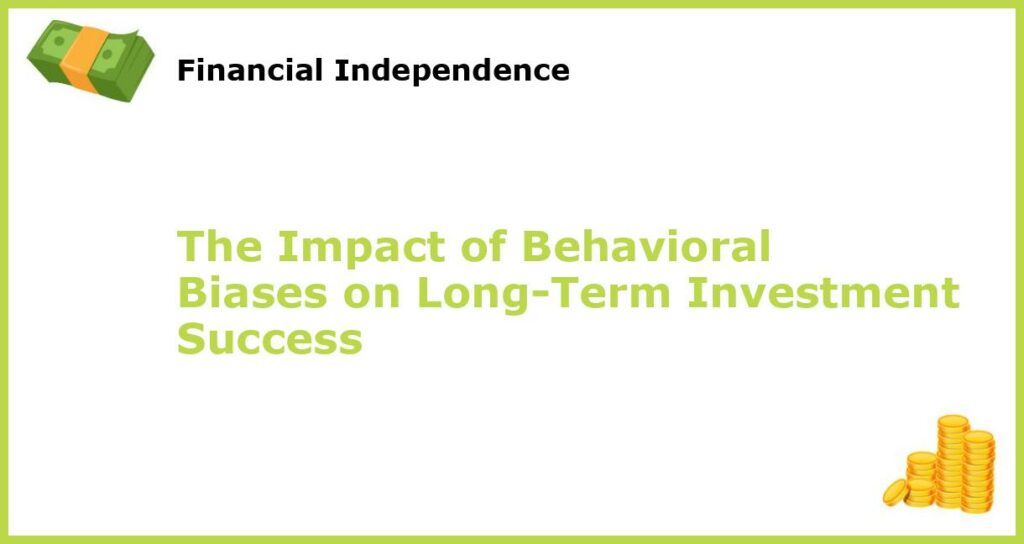Investing is a complex task that requires continuous attention and rational decision-making. However, in reality, investors tend to exhibit behavioral biases that can influence their decision-making capabilities. Behavioral biases can be cognitive, emotional, or social in nature, and they can lead investors to make suboptimal investment decisions. In this article, we will explore some of the most common behavioral biases that investors exhibit, and their impact on long-term investment success.
Overconfidence Bias

Overconfidence is one of the most common cognitive biases that investors exhibit. Investors who suffer from overconfidence bias tend to think that they are better at making investment decisions compared to others. As a result, they tend to overtrade and make impulsive investment decisions. This bias can be detrimental in the long-term, as it can cause investors to ignore important risks and make reckless investment decisions. For instance, overconfident investors may trade too frequently or fail to diversify their portfolios appropriately. The impact of such decisions can be grave on an investor in the long term, such as missing opportunities and suboptimal investment returns.
Fear and Loss Aversion Bias

Fear and loss aversion bias are emotional biases that many investors exhibit. Investors who suffer from this bias tend to be overly cautious and risk-averse and avoid investments that they perceive to be too risky. This bias can lead to missed opportunities and suboptimal investment returns. For instance, such an investor may shy away from buying stocks in healthy sectors such as technology or healthcare, fearing that they may lose their investments. Consequently, fear and loss aversion bias can cause an investor to ignore the potential of high-risk-return diversification and harm their investment success.
Herding Bias

Herding bias is a social bias that occurs when investors follow the actions of the crowd. Investors often follow the crowd even when it is not in their best interest, leading to investment bubbles and busts. This bias can be especially dangerous in the age of social media, where investors are increasingly influenced by the opinions of others. Herding bias can cause investors to miss out on profitable long-term investments and signal weaknesses in decision-making skills.
Confirmation Bias
Confirmation bias is another cognitive bias that affects investor behavior. This bias makes investors seek out information that confirms their existing beliefs and opinions, while disregarding information that contradicts their views. Confirmation bias can lead to poor investment decisions, as investors may cling to faulty beliefs even when presented with evidence to the contrary. This bias can be detrimental to an investor’s long-term investment success, as it can lead them to put confidence in a failing investment.
Anchoring Bias
Anchoring bias is a cognitive bias that occurs when investors rely too heavily on a particular piece of information when making investment decisions. This information can be any relevant detail that investors link their decisions to, such as stock price or market performance. This bias can be especially harmful in the long-term, as investors may ignore new information that challenges their existing beliefs. For instance, an investor may hold on to an underperforming stock, assuming that it will rise back to its original price, simply because it was at its previous value when they purchased it.
Greed Bias
Greed bias is an emotional bias that makes investors overly optimistic about their future investment returns. This bias can cause investors to take excessive risks and engage in reckless behavior in the pursuit of higher returns. Greed bias can be especially dangerous in the long-term, as investors may overallocate their portfolios to high-risk investments, putting their entire portfolio at risk. Greed can lead investors to engage in investments that otherwise they wouldn’t, disregarding their logical decision-making skills.
Regret Aversion Bias
Regret aversion bias is an emotional bias that afflicts investors who avoid taking risks out of fear that they will regret their decisions later. This bias can lead to missed opportunities and suboptimal investment returns, as investors may avoid taking risks that could lead to higher returns. For instance, an investor may hold off on investing in a profitable stock because they are unsure of its future stability. Consequently, they miss out on significant gains simply because they were too afraid to invest.
Recency Bias
Recency bias is a cognitive bias that occurs when investors give too much weight to recent events when making investment decisions. This bias can lead to poor investment decisions, as investors may ignore broader trends and patterns in the market in favor of short-term fluctuations. This bias can be especially hazardous in the long-term as it can cause impulsive decisions based on short-term trends affecting portfolio stability.
Illusion of Control Bias
Illusion of control bias is a cognitive bias that occurs when investors believe that they have more control over their investments than they actually do. This bias can lead to overconfidence and lead investors to make impulsive investment decisions. Illusion of control bias can be particularly dangerous in the long-term, as it can cause investors to ignore risks and make reckless decisions. For instance, an investor may trade frequently, paying little attention to the long-term impact of these trades or the underlying cause of market trends.
Self-Attribution Bias
Self-attribution bias occurs when investors attribute their investment success to their own abilities rather than to external factors such as luck. It can lead to overconfidence and make investors more likely to take undue risks in pursuit of higher returns. This bias can be particularly dangerous in the long-term, as it can cause investors to ignore risks and become overly confident in their investment decisions. Such an investor may believe that the safety of their investments is secure because of their individual security analysis.







